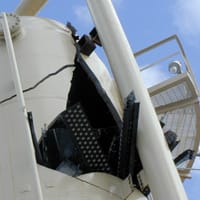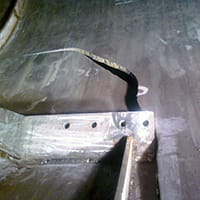Brittle Fracture


Auto-refrigeration can impose low-temperatures onto process vessels and piping causing them to be at risk of brittle fracture. Brittle fracture is the sudden break-before-leak phenomena that can result in catastrophic rupture of the equipment. Operating excursions and the resulting auto-refrigeration conditions with subsequent recovery chain of events can be evaluated to determine if the equipment is subject to this potential process hazard. If this vulnerability is identified, a layer of protection analysis (LOPA) can be executed to evaluate and develop mitigation actions.
At Stress Engineering Services, we use a comprehensive approach to identifying susceptible equipment, executing the brittle fracture analysis, and performing the process hazards analyses to evaluate and develop mitigation for at-risk vessels and piping. With this approach, the equipment is evaluated using Part 3 of API-579-1 / ASME FFS-1 Fitness for Service methods to develop a minimum allowable temperature (MAT) curve. Process hazards scenarios are developed using the dynamic and sequence driven methodologies to compare to the equipment MAT curve. If adequate mitigation cannot be attained through normal means (administrative controls, alarms, interlocks) additional computational analyses is performed and potentially justifying the fitness for service of the equipment under this excursion condition.
Our Experience With Brittle Fracture Analysis
For years, our brittle fracture engineers have successfully applied this method on thousands of vessels and piping systems at chemical, refinery and offshore facilities. Our analysis methods, coupled with our highly experienced personnel provides clear scenario descriptions and can indicate potential fitness for service risk, thus allowing for the development of lowest life cycle cost for mitigation.
Auto-Refrigeration / Brittle Fracture Hazard
- Significant hazard to Olefins and Light Liquid Hydrocarbon processing units
- Refinery processes at risk both from auto-refrigeration but also other embrittlement mechanisms (hydrogen or temper embrittlement)
- Materials of construction selection drives hazard potential
- Root cause of a number of industry incidents
Governmental and Industry Approach
- USA OSHA 1910.119 requires documentation of vessel and piping fitness-for-service.
- Associated refinery national emphasis program (NEP) list API-579 / ASME FFS-1 as basis for establishing fitness for service minimum temperature on vessels and piping
- The olefins and hydrocarbon processing industries have experienced a number of brittle fracture failures due to exposure to low temperatures due to auto-refrigeration.



